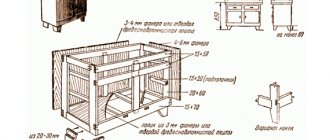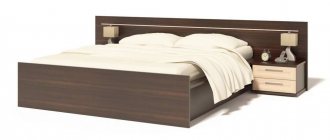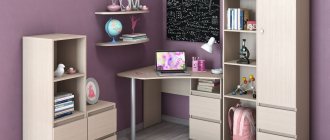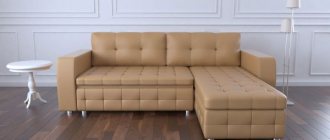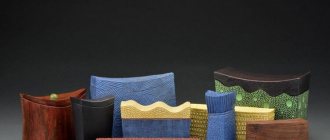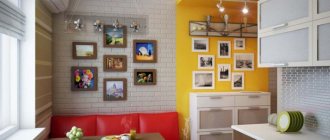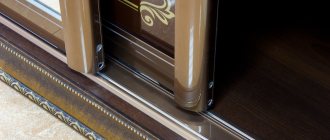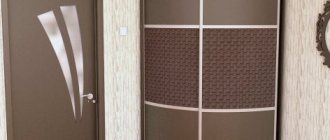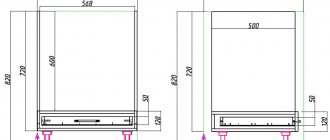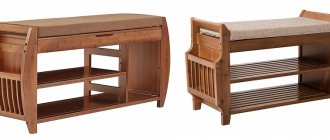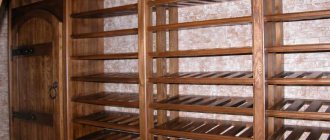Owners of small apartments often opt for cabinets installed in the corner, but before ordering such furniture, you need to have a drawing of a corner cabinet with dimensions on hand. After all, such structures must stand clearly on the wall, without deviating even a degree from the angle.
Corner cabinet drawing with dimensions
Corner cabinets are popular because they are quite ergonomic and allow you to save space in a small room. In addition, you can make a cabinet with your own hands using a drawing and detailed instructions. We will talk about this below.
Designing a corner cabinet according to the drawing
Types of corner cabinets
In order to create a unique, functional design, furniture makers are experimenting with different shapes of cabinets. There are the most popular product configurations that should be studied before drawing.
Table No. 1. Types of corner cabinets.
| Illustration | Description |
| Such structures are installed in the corners of small rooms. In this case, most often they are fixed directly to the wall - this shape allows you to properly smooth out the corners. The cabinet does not have full side walls, so its shelves are triangular. | |
| In this design, there is a wall on one side. Therefore, such a cabinet is considered more practical than the previous option. There is more free space inside. | |
| One of the most popular forms of cabinets. The design consists of two parts that connect at the corner. Such products are distinguished by their spaciousness. | |
| A special feature of the design is the presence of small but functional side walls. Due to this, additional modules can be placed inside the cabinet. |
The most difficult design for self-production is a triangular or trapezoidal cabinet - due to the fact that the product involves the presence of diagonal elements, which it is advisable to prepare in the presence of a professional.
Table No. 2. Types of corner cabinets according to installation method.
| Installation method | Description |
| Hull | Such cabinets require a back wall; they are not tied to just one place. If necessary, they can be quickly transferred. |
| Built-in | The cabinet is assembled and secured directly in the place where it is planned to be installed. It is quite difficult to move such a structure to another place. |
| Modular | The design consists of several sections that are assembled into one cabinet. Such products can be dismantled and rearranged quite quickly (if necessary). |
The designs differ from each other and in the type of doors. They can be hinged or sliding (compartment). In the first case, door leaves should not be made larger than 45 centimeters, otherwise the load on the hinges will be too strong. In the second case, the doors can be quite massive, even more than 45 centimeters wide.
Accommodation options
In the bedrooms. with a traditional interior The ideal appearance is for furniture made of MDF or cardboard, covered with film, plastic layer or veneer. Using a mirror sheet you can not only enlarge the room, but also correct some vision problems. Many designers love to use high-strength glass, which allows them to show their imagination and implement the most daring projects.
Country style Helps you feel calm and at ease, freeing you from the burden of problems that constantly torment you. Keep it simple - avoid bright colors and designs, the less elaborate the wood looks, the more precise the style canon.
As for the installation location, most experts believe that the best solution is where the walls touch each other. If desired, you can cover one of the walls and leave the other unfurnished.
One of the placement options is the kitchen. The kitchen has its own unique arrangement of cabinets in any room, but even against this background, the kitchen stands out from the rest. Each room has its own specific cabinet layout, but even against this background, the kitchen stands out. There is always a shortage of space, so any way to improve the efficiency of using space, even just a little, is beneficial. Remember that measuring surfaces and ordering pieces only makes sense when leveling the floor, walls and ceiling - otherwise the cabinet may not fit in the given space.
To properly design a corner kitchen cabinet, you need to use only two types of connections (at a right angle you need to connect to the countertop, and at an angle of 45 degrees to the sink). Unlike the direct option, it is necessary to provide additional inserts (they perform two functions at once - mechanically connecting the drawers and replacing the front part). The cornice is made at the top and bottom.
It is impossible to correctly calculate the structure and estimate the material consumption for it without taking into account the fact that the upper and lower elements are located in the space separating the side blades, otherwise it will not be possible to correctly design the front part. The tabletop must have an identical geometric shape.
Material selection
Table No. 3. The most common materials for making cabinets.
| View | Description |
| Natural wood | This is the most environmentally friendly and expensive option for making furniture. Cabinets of this type are distinguished by their strength, durability, and at the same time they have an impressive weight. In addition, wood products have an unusual decorative appearance, they have a unique texture. It is recommended to choose the most durable wood options - oak, pine. It should be taken into account that such material is deformed when exposed to high temperatures and humidity. In addition, it is exposed to pests. |
| MDF | This material is a mixture of wood chips, various fibers and resin. The main advantage of the material is its affordable cost. Thanks to proper processing, MDF boards are durable and quite easy to process. In addition, they do not deform over time and have a very fine texture that does not stand out. Another obvious advantage is the large size of the slabs. |
| Plywood | This is a fairly strong material that is suitable for creating a cabinet frame. It is recommended to use only multi-layer plywood for such purposes. Like natural wood, this material can become deformed as a result of exposure to moisture. |
| Drywall | This material is often used to cover the frame of corner cabinets. It is lightweight, so installation will not seem difficult even for a beginner. In addition, some types of drywall have good resistance to humidity and temperature changes. |
Creating a Project
Before you start creating a drawing of the future structure, it is important to determine the place where it will be installed. At this stage, the following points should be taken into account: the number of shelves, drawers (if required). All this will allow us to develop the most detailed project.
It is important to observe the following nuances:
- Not all apartments have standard, smooth walls and ceilings. This is why measurements should be taken from all sides, especially when designing a built-in wardrobe.
- The depth of the finished cabinet should be at least 60 centimeters. Otherwise, such shelves will not be spacious.
- Measurements should be immediately transferred to the drawing in order to correctly calculate the amount of materials.
- If necessary, you should first level the floor in the place where you plan to install the cabinet.
- To apply markings, you must use a building level, a square and a tape measure.
Sample drawing with dimensions
The diagram of a corner cabinet is drawn starting from the sides, because they are load-bearing and represent the appearance of whole boards. Then you should determine the height of the structure (usually from 2.2 meters).
Only then do you need to calculate the dimensions of the horizontal parts and the rods (if it is a wardrobe). Most often, large shelves are installed at the top of the cabinet, and a bar directly in the corner. The last step is to add additional designations to the diagram where mirrors, lighting and other elements will be located.
Drawings and diagrams
The most important thing when creating a corner cabinet is to create a correct and accurate diagram and drawings. If they contain any errors, then it will not be possible to build a complete, durable and stable structure.
Drawings and diagrams can be obtained in different ways:
- independent creation, and the process can be performed manually or using special computer programs;
- ordering from specialists, which will require significant financial investments;
- search for ready-made drawings, but you should only use them if you are sure that they are correct and accurate.
Corner cabinets are considered an excellent solution for different rooms. They can be created from different materials, but the most optimal is the use of plasterboard, which is used to cover a frame made of metal profiles. Such a cabinet will not require significant investment and is also easy to create. During independent work, your own wishes and the existing dimensions of the selected angle are taken into account, so the design will be ideal for the installation location.
Corner cabinet shapes
Corner cabinet made of wood or MDF
To manufacture and assemble the cabinet you will need the following materials and tools:
- processed wood or MDF sheets;
- euroscrews, dowels;
- glue;
- corners or ties;
- accessories;
- drill;
- screwdriver;
- measuring tape;
- level;
- a circular saw;
- hammer.
Construction fasteners
Video - How to assemble a corner wardrobe
Manufacturing of elements
Experts do not recommend cutting the material at home, because there is a high probability of getting crooked parts. It is advisable to contact a furniture shop with your cutting diagram, where specialized equipment is available.
At the same time, some craftsmen prefer to prepare parts for the cabinet themselves. In this case, you must have at least minimal experience in furniture making.
MDF cutting process
Step-by-step instruction.
Step 1. We cut out the parts of the walls, shelves, doors, drawers from the sheet. For such purposes, a circular saw or hacksaw is usually used. In this case, the second option is chosen very rarely, because damage may remain on the parts.
Sawing out wall parts
Step 2. It is necessary to process the edge of each part using polymer tape. It is applied to the edge and then fixed with an iron or hot air.
Edge processing
Step 3. The edge tape will need to be carefully smoothed using a cloth. After that, the remaining pieces of tape must be carefully cut off with a sharp blade.
Smoothing the tape with fabric
Assembly of the structure
When all the parts and tools are ready, you can begin the process of assembling the structure.
Table No. 4. Assembling corner cabinet parts.
| Illustration | Description |
Measurements | You need to double check that the dimensions are correct. Therefore, before starting work, it is necessary to measure the walls. |
Installing the feet | Next, you should install the legs on the bottom of the corner structure. They are fixed using self-tapping screws. Moreover, some models require the presence of a special base at a distance of 5 to 10 centimeters from the floor. In any case, the doors should not touch the floor, so installation of a support is required. |
Support placement | The bottom with support must be placed in the corner. It must be stable, so it should be installed level. To do this, use a building level, which can be used to raise and lower the legs. |
Installation of walls | Installation of the walls of the structure. They are secured with special ties or metal corners. In most cases, the first option is used, because such fasteners securely fix the parts and remain invisible. |
Lower segment fastening | Fastening the subsequent lower segment of the structure. The legs are installed on it, and then it is fixed to the main body. To do this, it should be installed flush against the corner structure of the cabinet and leveled using a building level. |
Side panel installation | Installing the sidewall. It is fixed at the junction of the lower parts. In this case, it is better to install it even before fixing the parts of the bottom. |
Connecting elements | Connecting base elements using furniture ties. To do this, pre-drill holes. |
Wall installation | Installing the next side wall. At this stage it is necessary to install the top panel of the frame. This will give it more stability. Otherwise it may become loose. |
Sidewall fixation | Sidewall fixation. Before securing it with furniture ties, you need to adjust the position according to the level. |
Installation of panels | Other panels of the structure are installed in the same sequence. Their number will depend on the size of the cabinet. It is worth noting that it is much easier to assemble a cabinet with such small fragments. |
Completing the build | It is necessary to complete the assembly of the frame and then check its stability. |
Installation of internal parts and doors
Table No. 5. Stages of installation of internal elements and fastening of doors.
| Illustration | Description |
Installation of vertical elements | Installation of vertical elements and drawers. There are two ways to install shelves. In the first case, they are fixed using metal corners and euroscrews, but then they will be motionless. In the second case, you can install special holders on which shelves are installed on top. Drawers are mounted on guides, thanks to which they will slide out quickly and smoothly. |
Securing the rod | Fastening the figured rod to the brackets. Install it on a shelf, which is then connected to the structure. |
Shelf installation | Installing a shelf with a rod. It should be secured inside the corner structure. In the same way, you need to fix another shelf in another corner. |
Door installation | Door installation. This process consists of the following stages: 1. Parts of hinges (furniture) are attached to the walls of the frame. 2. After which another part of the hinges is installed on the doors themselves. 3. Then the hinges must be connected and secured with screws. After which you will need to adjust the position of the valves. |
Eliminating the top hole | Next, you need to eliminate the hole between the ceiling and the structure. |
Eliminating the Bottom Hole | The lower hole is covered with a chipboard panel or plinth of the appropriate size. |
Checking the stability of the cabinet | Upon completion of work, it is necessary to check the stability of the cabinet again. If there are no flaws, then the design can be used. |
How to inexpensively make a design project of a product according to your dimensions using someone else’s hands
There are different options for how to make a corner cabinet with your own hands according to a finished project. The necessary drawings can be ordered through specialized services where professional designers and constructors work.
Search for a designer on Avito
The Avito advertisement portal constantly publishes advertisements from various designers and furniture designers. You can contact a suitable specialist and directly discuss all the terms of cooperation.
Negotiations with local designers
If there is a design studio in your city, or you know specialists in this industry, try to consult with them and find out about the prices for drawing up design projects. At the negotiation stage, all nuances and details should be discussed in order to avoid mistakes when drawing up drawings of sliding wardrobes.
Placing an order on the remote service FL.ru
It is also possible to order a cabinet design service through the freelance service FL.ru. In this case, you yourself will be able to indicate the desired price, terms of cooperation and technical specifications. The portal employs thousands of specialists in the field of furniture design, who will easily prepare a project in a short time and at an affordable price.
Corner cabinet made of plasterboard
Before manufacturing and assembling a plasterboard cabinet, you must prepare the following materials and tools:
- sheets of drywall of the required size;
- metal profiles (racks and guides);
- accessories;
- measuring tape;
- scissors for metal and drywall;
- corners for fixing protrusions;
- self-tapping screws (for drywall);
- set of dowels;
- building level;
- screwdriver;
- putty;
- putty knife;
- sandpaper;
- jigsaw (for cutting sheets);
- additional elements;
- hammer drill (for holes for screws);
- decorative plaster for finishing cladding.
If you have the above materials and tools, you can begin the process of manufacturing the structure.
Video - How to make a built-in wardrobe from plasterboard
Frame installation
Step-by-step instruction.
Step 1. It is necessary to apply markings to the walls. At this stage, you should mark the installation locations of the structure to the wall using a pencil. For greater reliability, it is recommended to double-check these values several times.
Marking the walls
Step 2. You need to start attaching metal profiles (guides) to the wall using self-tapping screws. At this stage, accuracy is especially important, so do not rush. Each element must be securely fixed, because the metal frame will carry the entire load. The screws are screwed in increments of no more than 100 millimeters, thanks to which the entire structure will be stable.
Each element must be recorded
Step 3. It is necessary to install the rack profiles into the guides. To do this, use self-tapping screws or Euroscrews. Since this is a corner cabinet, the profiles will need to be given the necessary bend so that they fit into the structure without any obstacles. To do this, a notch is made on the beams with metal scissors. Such actions will allow you to quickly bend any profile.
Installing profiles
Step 4. If you plan to install a large cabinet, then it is recommended to further strengthen the structure of the profiles. This can be done using the remaining profiles from which the jumpers are formed.
Strengthening the structure
Step 5. Before starting the process of covering the structure with sheets of plasterboard, it is necessary to secure the corners. They are made from fragments of the remaining profiles, but if desired, they can be purchased at any hardware store.
Securing corners
Important point! Instead of metal profiles, wooden blocks are sometimes used to make the frame, but this is not the best solution. After all, wood tends to shrink, which means the plasterboard structure can become deformed, causing cracks to appear in the plaster.
Sheathing of the structure
When the frame is completely ready, you can begin the sheathing process. This is quite easy to do if you follow the instructions.
Step-by-step instruction.
Step 1. It is necessary to fix the plasterboard sheet in the inside of the cabinet structure using self-tapping screws. After which, you should completely cover this part with sheets. It is important to remember that the pitch between the screws should be more than 150 millimeters. At the same time, they are deepened into the sheet by 1.5 millimeters so that the fasteners do not show through from the outside. You can read more about how to make fasteners for shelves with your own hands in our article.
Fixing the sheet
Step 2. Then you need to finish the outside of the structure with plasterboard. Such actions should be performed especially carefully to avoid mistakes.
Finishing the outside of the structure
Exterior finishing
When the plasterboard frame is ready, you should begin finishing its exterior using putty.
Large putty manufacturers
Step-by-step instruction.
Step 1. First, you need to apply a fairly thick layer of putty to hide the drywall seams and uneven areas. The structure must be left in this form for some time until the putty hardens.
Applying putty
Step 2. You will need to carefully sand the dry surface. This is done in order to remove sagging.
It is necessary to remove sagging with sandpaper
Step 3. The last layer is the final one, so it should be applied especially carefully.
Need to work carefully
Step 4. When the surface has dried, you need to go over it again with sandpaper in order to prepare for decoration.
Preparing for decoration
Step 5. The last stage is decorating the cabinet. Finishing can be done using decorative plaster and various moisture-resistant paints.
Cabinet decoration
Finishing
Finishing involves the following steps:
- all surfaces outside and inside are covered with a high-quality primer;
- joints are filled with gypsum plaster;
- then the serpyanka is glued;
- Painting corners are mounted at the corners;
- putty is applied, which is sanded after hardening;
- It is advisable to make two layers of putty;
- then the primer is applied again;
- then final finishing materials are applied, which can be represented by decorative panels, tiles or other materials.
It is advisable to use a mirror during finishing to increase the comfort of using the structure.
Perforated angle for processing corners
Cabinet Finish
Structural additions for corner cabinets
In order to create a complete look, open modules are installed in the side parts of the corner structure. They are a type of various shelves that are attached to the cabinet or installed end-to-end without fastenings. Thanks to this solution, you can make any large-sized product more interesting. In addition, such shelves are functional elements; they are often made of glass or plastic.
Additional shelves
Quite often LED lamps are built into cabinets. It is important to consider the total number of lighting fixtures in the room. Otherwise, this is a good addition, thanks to which the contents of the cabinet will be clearly visible, especially in five-wall structures.
Lamps in the corner cabinet
Internal structure
The interior design of the cabinet can be determined individually. The most popular options are:
- on the left are shelves, in the middle are slats for clothes, on the right are drawers. Ideal for the bedroom;
- in the middle there are clothes rails, on the sides there are shelves. Good choice for living room;
- on the left there are two sections with shelves, on the right there are full-length shelves, at the bottom there are sections for large items and boxes.
Universal recommendations for making furniture
Making furniture is always more difficult for beginners, so experienced craftsmen recommend listening to the following recommendations:
- If natural wood is used in the manufacture of the cabinet, it should be pre-treated and dried (humidity no more than 15%).
- There is no need to save money on accessories. In the case of swing doors, it is advisable to purchase European-made hinges, despite the fact that they have a higher cost. Otherwise, low-quality products can quickly fail.
- When making a built-in wardrobe from wood or plasterboard, you will need to carefully level the floor. It should be borne in mind that even due to the slightest deviations, the design will be crooked.
- For beginners, it is better to first experiment with the manufacture and assembly of smaller structures. For example, it could be a small cabinet. Then you will have at least the slightest experience in making furniture.
- In a hurry, you can easily confuse different panels and install them incorrectly. Therefore, there is no need to rush; it is better to assemble the structure gradually. It is recommended to roughly divide the work into several stages in order to have a clear plan.
Before starting the manufacture or assembly of any structure, it is better to consult a professional
It is also worth noting that the assembly of large-sized structures should not be done by one person. Therefore, it is better to take care of this in advance and involve another person in this matter.
